Total volume of fisheries production records a 7.9 percent decrease
During the fourth quarter of 2024, fisheries production in Davao de Oro totaled 679.2 metric tons, reflecting a 7.9 percent decline from the 737.4 metric tons recorded in the same quarter of the previous year. The decrease was primarily observed in the marine and inland municipal fisheries subsectors. Meanwhile, the aquaculture subsector reported an annual increase in production. (Figure 1 and Table 1)
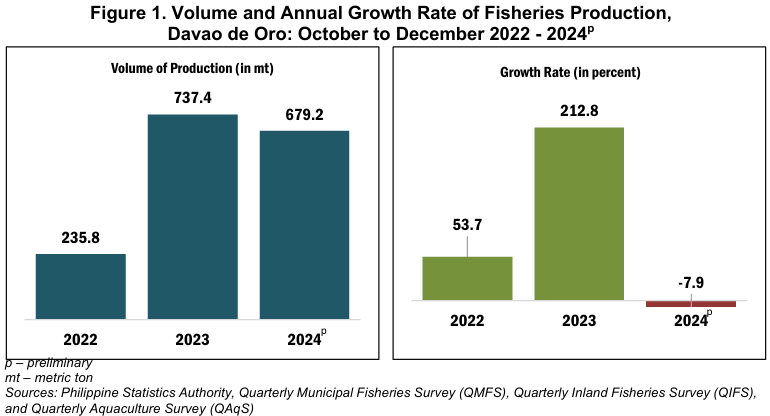
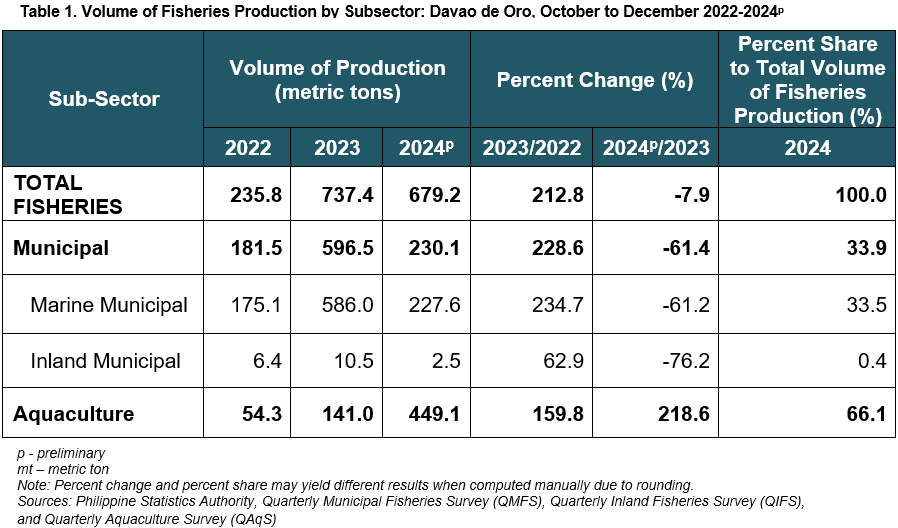
The volume of fish production in Davao de Oro is attributed to three subsectors: commercial, municipal, and aquaculture. However, it's important to note that commercial fisheries are not applicable in Davao de Oro, as the province does not have any commercial fishing operations. In the fourth quarter of 2024, aquaculture accounted for the largest share of total fisheries production, contributing 66.1 percent to the overall volume. The remaining 33.9 percent came from municipal fisheries, which included both marine and inland fishing. Of this, marine municipal fishing comprised 33.5 percent, while inland fishing contributed 0.4 percent. (Figure 2 and Table 1)
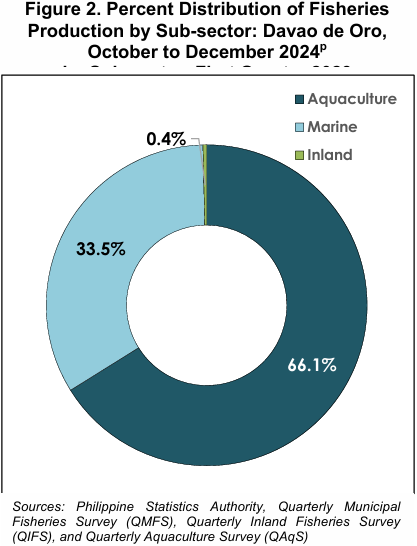
Marine municipal fisheries production declines by 61.2 percent
The volume of production for marine municipal fisheries was recorded at 227.6 metric tons during the quarter, reflecting a 61.2 percent decrease from the 586.0 metric tons recorded in the same quarter last year. The subsector accounted for 33.5 percent of the total fisheries production during the period. (Figure 3 and Table 1)
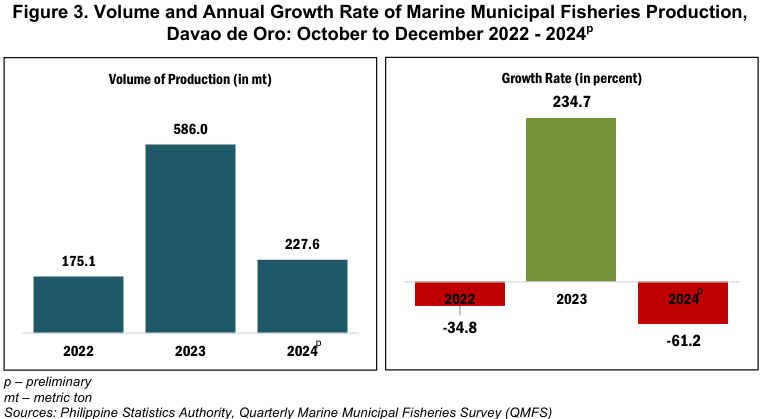
Bali Sardinella remains the top species in marine municipal fisheries
In the fourth quarter of 2024, the top three species caught in marine municipal fishing were Bali Sardinella, Squid, and Mullet. Bali Sardinella had the highest catch at 48.4 metric tons, followed by Squid with 29.7 metric tons and Mullet at 20.6 metric tons. (Table 2)
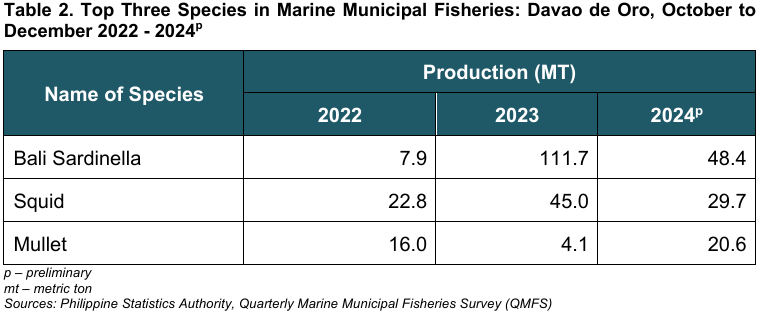
Inland municipal fisheries production reduces by 76.2 percent
During the quarter, inland municipal fisheries’ production dropped to 2.5 metric tons, marking a 76.2 percent decline from the previous year's estimate of 10.5 metric tons. The subsector contributed 0.4 percent to the total fisheries production during the period. (Figure 4 and Table 1)

Aquaculture production increases at 218.6 metric tons
Aquaculture production was estimated at 449.1 metric tons during the quarter, marking a significant 218.6 percent increase from the 141.0 metric tons recorded in the same period of 2023. This growth highlights the expanding role of aquaculture in the fisheries sector, with the subsector accounting for 66.1 percent of the total fisheries production. (Figure 5 and Table 1)
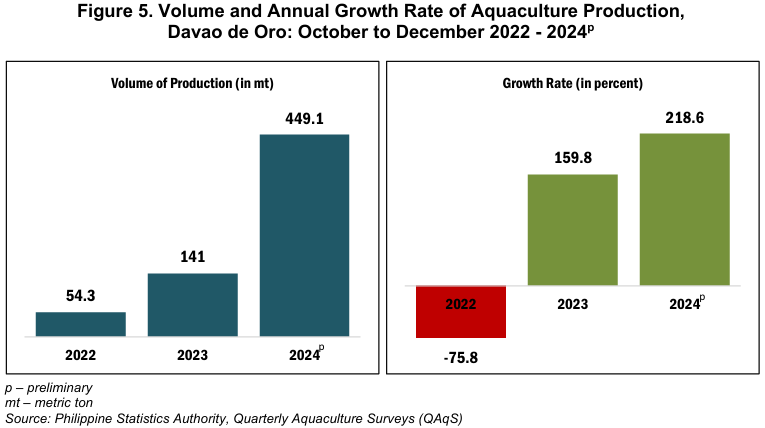
Among the aquaculture subsectors, only brackishwater fishponds and marine cages exhibited positive growth compared to the previous year. Brackishwater fishpond production surged by 199.7 percent, increasing from 27.3 metric tons to 81.8 metric tons. Meanwhile, marine cage production grew at an even higher rate of 275.2 percent, rising from 95.0 metric tons in 2023 to 356.6 metric tons in the current quarter of 2024. This notable growth highlights the increasing contribution of these subsectors to overall aquaculture production. (Figure 6 and Table 3)
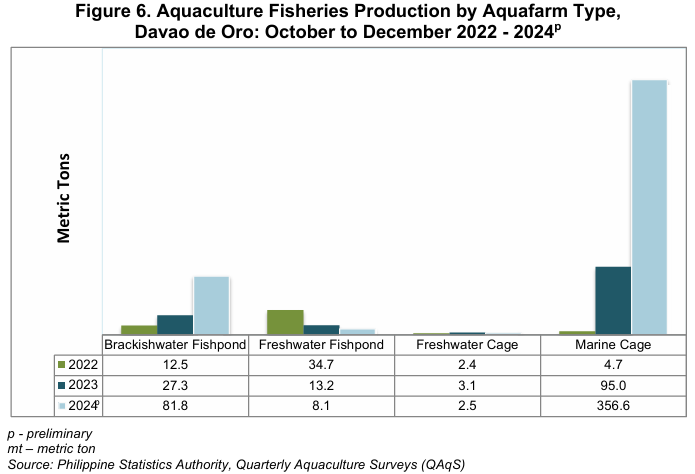
On the other hand, the remaining aquaculture subsectors experienced negative growth. Freshwater fishpond production declined by 38.6 percent, while freshwater cage production dropped by 18.8 percent, indicating a slowdown in these aquaculture activities. (Figure 6 and Table 3)
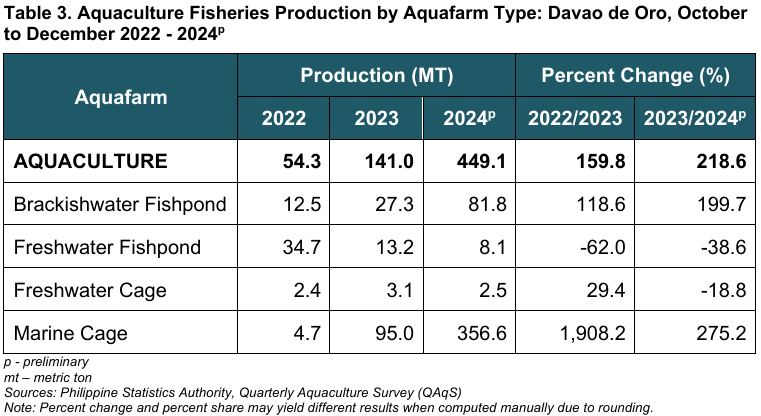

TECHNICAL NOTES
Commercial fishing – is the catching of fish with the use of fishing boats with a capacity of more than three gross tons for trade, business, or profit beyond subsistence or sports fishing.
Municipal Fishing - covers fishing operations carried out with or without the use of a boat weighing three gross tons or less.
Inland Municipal Fishing - the catching of fish, crustaceans, mollusks, and all other aquatic animals and plants in inland water like lakes, rivers, dams, marshes, etc. using simple gear and fishing boats some of which are non-motorized with a capacity of three gross tons or less; or fishing not requiring the use of fishing boats.
Aquaculture - fishery operation involving all forms of raising and culturing of fish and other fishery species in marine, brackish, and freshwater environments. Examples are fishponds, fish pens, fish cages, mussels, oysters, seaweed farms, and hatcheries.
Aquafarm - the farming facilities used in the culture or propagation of aquatic species including fish, mollusks, crustaceans, and aquatic plants for purposes of rearing to enhance production.
Brackish water – is a mixture of seawater and freshwater with salinity that varies with the tide. Examples are estuaries, mangroves, and the mouths of rivers where seawater enters during high tide.
Fisheries - all activities relating to the act or business of fishing, culturing, preserving, processing, marketing, developing, conserving, and managing aquatic resources and the fishery areas including the privilege to fish or take aquatic resources thereof (RA 8550).
Fisheries Sector - the sector engaged in production, growing, harvesting, processing, marketing, developing, conserving, and managing of aquatic resources and fishery areas.
Fish Cage - stationary or floating fish enclosure made of synthetic net wire/bamboo screen or other materials set in the form of an inverted mosquito net ("happy" type) with or without cover with all sides either tied to poles stacked to the water bottom or with anchored floats for aquaculture purposes.
Fishing Gear - any instrument or device and its accessories utilized in taking fish and other fishery species.
Fishing Grounds - areas in any body of water where fish and other aquatic resources congregate and become the targets of capture.
Fish Pen - an artificial enclosure constructed within a body of water for culturing fish and fishery/ aquatic resources made up of bamboo poles closely arranged in an enclosure with wooden materials, screen, or nylon netting to prevent the escape of fish.
Fishpond - a body of water (artificial or natural) where fish and other aquatic products are cultured, raised or cultivated under control conditions. This island-based type of aquafarm. Note that the setting-up of fish cages in ponds does not make the operation of the fish cage at the same time a fishpond.
Freshwater – is water without salt or marine origins, such as generally found in lakes, rivers, canals, dams, reservoirs, paddy fields, and swamps.
Landing Center – a place where the fish catch, and other aquatic products are unloaded and traded.
